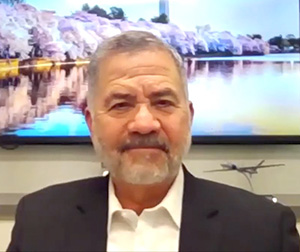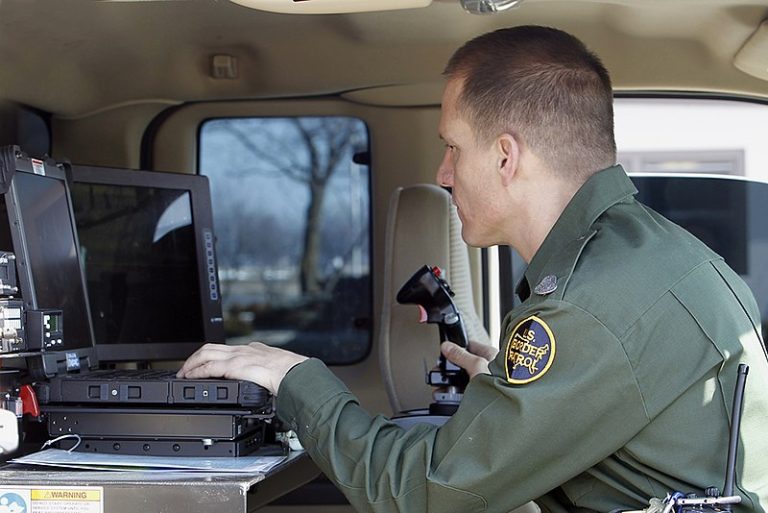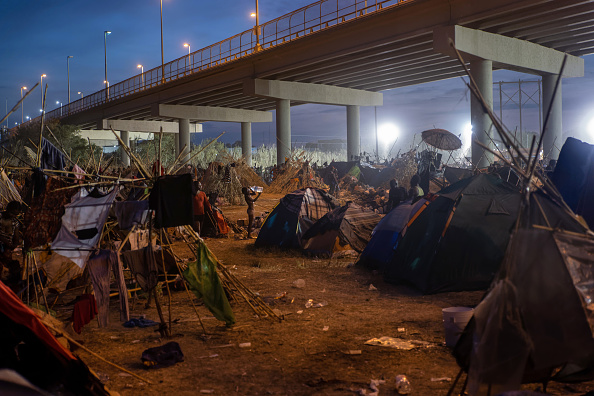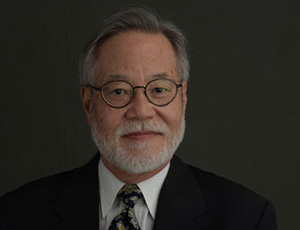The following is a transcript of the video briefing above, lightly edited for clarity and presented here to enable users to search the participants’ comments.
DW Gibson: A Rhodes Scholar and a graduate of Yale Law School, Alan Bersin served as Assistant Secretary of International Affairs and Chief Diplomatic Officer at the Department of Homeland Security. In 2010, President Obama appointed him as the commissioner of U.S. Customs and Border Protection, where he served until the end of 2011. And from 2012 to 2015, he was vice president of Interpol for the Americas region and a lead member of the Interpol executive committee. Mr. Bersin is currently a fellow in several programs, including Harvard University’s John F. Kennedy School of Government, the Wilson Center, and the Aspen Institute in Mexico.
With this body of work and study, Bersin has become a leading voice on the dynamics of global migration. In a paper published in September by the Migration Policy Institute, he details the need for a support network throughout the Western Hemisphere to address changing migration flows on the southwest U.S. Border. In that paper, he writes, and I quote, “It has become clear that nation states cannot successfully manage migration at their territorial border lines alone. This boundary, the ports of entries situated on it, and the corridors between them, are the last line of defense rather than the first.”
We are pleased to welcome Mr. Bersin today. Thank you for joining us.
Alan Bersin: Thank you, DW. And I appreciate the opportunity to dialogue with Ideaspace, and in it.
DW Gibson: Absolutely. So I’d like to just start the conversation by following up on that excerpt, which I think is really eye-catching. You put it into stark terms. The border is not the first line of defense, but the last. So with that in mind, I wonder if you could tell us what are those first lines of defense that we’re missing, so to speak? What are those places we might want to put more thought, more resources?
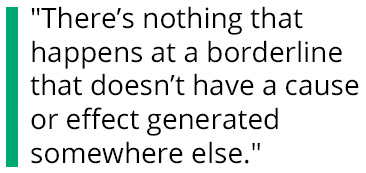 Alan Bersin: So we have to recognize, first of all, that the borderlines, the boundaries between nation states that define the separate nations, now 190 of them, actually are not where you can deal with problems. There’s nothing that happens at a borderline that doesn’t have a cause or effect generated somewhere else. So if you take all of the problems we’re familiar with, whether it’s migration [or some other challenge], this is not something that can be dealt with successfully because the push factors out of places like the Northern Triangle in Central America, or in past times, from Mexico, actually reflect conditions that are taking place in another country at another place. And if you want to deal with the underlying problems, you have to actually move and deal with them and deal with them cooperatively with neighboring countries or other partners in the international system.
Alan Bersin: So we have to recognize, first of all, that the borderlines, the boundaries between nation states that define the separate nations, now 190 of them, actually are not where you can deal with problems. There’s nothing that happens at a borderline that doesn’t have a cause or effect generated somewhere else. So if you take all of the problems we’re familiar with, whether it’s migration [or some other challenge], this is not something that can be dealt with successfully because the push factors out of places like the Northern Triangle in Central America, or in past times, from Mexico, actually reflect conditions that are taking place in another country at another place. And if you want to deal with the underlying problems, you have to actually move and deal with them and deal with them cooperatively with neighboring countries or other partners in the international system.
Another example obviously is narcotics. We look at all of the narcotics flowing through the southwest border. But in fact, it’s the demand for the drugs in the interior of the United States and the existence of transnational organized crime in Mexico that makes this possible. And on and on. If you look at any particular problem, you see that if you wait to deal with the issue at the borderline, you end up with a chaos that we’ve experienced in recent times with regard to migration.
DW Gibson: So you just tapped into one point I think is really essential. We seem to conflate a lot of the things that materialize at the border. Mainly two categories, people and goods. Items. So we have to think about the movement of items versus the movement of people. I know this is something you think about a lot, too. And I wonder how that affects the emphasis you put on ports of entry and viewing those as an important place to focus on when it comes to border security.
Alan Bersin: So border security consists of the ports of entry, 327 of them in the United States, airports, seaports, and land ports. On the southwest border, 46 land ports of entry between the United States and Mexico. On our Northern border with Canada, 127 land border ports. But we also have to think about the corridors between the ports of entry. So you have two areas that touch on border security. Between the ports of entry and at the ports of entry themselves. In the latter, you’re dealing with a regulated movement through a particular space, whereas in the corridors between the ports of entry, you’re dealing with an entirely different set of security issues because there is no checking in and checking out, so to speak. The U.S. Border Patrol handles the areas between the ports of entry on the northern and southern borders and the CBP Officers, the blue uniforms, so to speak, rather than the Border Patrols’ green uniforms, are the men and women that regulate the movement through the ports of entry. They involve different kinds of security measures, different perspectives, but the object is the same, to keep dangerous people and dangerous things away from the homeland, out of the United States.
But again, I want to go back to the first part of our discussion. If you wait for the borderline, if you wait to do it only at the borderline rather than engaging with partners abroad both in the NGOs as well as the public sectors, you will run into the problems that frankly, both the Trump and the Biden administrations [have encountered]; however different their approaches may have been, both administrations have suffered from this, what I call the myopia of border security.
[DW Gibson: Focusing on the results that we see at the border as opposed to the causes. You talk in your essay a lot about the need for cooperation. Regional cooperation. The thinking that one nation state can handle these things on their own in isolation is really a dated idea. So really looking for those points of a collaboration that could happen, or that might become necessary when we think about migration management, I wonder if you could talk about some of those tools that we could maybe implement when it comes to cooperation. I know one place you focus on in your essay is the idea of even data collection and intelligence. How that’s important as the first step to understanding what challenges the U.S. might be facing in two weeks, or two months, or six months at its border. So maybe talk even there about intelligence and data collecting and how that might play out.
Alan Bersin: Yeah. So in a global world, in a digital world, you really have to engage in cooperative activities. And we do, actually with Mexico and Canada. There is an information exchange so that anyone entering into a port of entry in Canada or Mexico, and likewise those coming into the United States, this information is available to our land border partners. So that in fact, there is a North American perimeter in terms of information sharing on who is actually entering the continental perimeter. What we see though, is that there is always the sovereignty concern. So we have this collision, so to speak, between the sovereign power to control borders, which is granted and inherent in national power, coupled with a global world in which the flows of goods, people, ideas, cyber electrons toward the country, is not containable at the borderline itself as we’ve discussed.
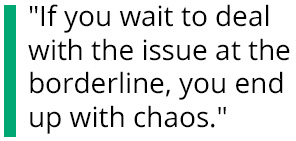 So unless there is a lot of both information sharing, intelligence sharing, data sharing to make usable information that can be used tactically and operationally, it becomes very difficult to control these global flows moving toward the borderline. And we see cooperation to a lesser or greater extent depending on the context in which we seek it. So in border control and migration control, we’ve seen significant cooperation between the United States and Mexico, both in the Trump administration and now again in the Biden administration. Because we recognized that unless the flows of migrants from Central America and from outside of Central America are dealt with in concert with Mexican authorities, we end up with the situation we saw in Del Rio a couple of months ago with tens of thousands of people gathered under bridges in Del Rio, Texas, or we see the caravans of Central Americans coming forward.
So unless there is a lot of both information sharing, intelligence sharing, data sharing to make usable information that can be used tactically and operationally, it becomes very difficult to control these global flows moving toward the borderline. And we see cooperation to a lesser or greater extent depending on the context in which we seek it. So in border control and migration control, we’ve seen significant cooperation between the United States and Mexico, both in the Trump administration and now again in the Biden administration. Because we recognized that unless the flows of migrants from Central America and from outside of Central America are dealt with in concert with Mexican authorities, we end up with the situation we saw in Del Rio a couple of months ago with tens of thousands of people gathered under bridges in Del Rio, Texas, or we see the caravans of Central Americans coming forward.
This requires the kind of cooperation that often can be obtained, but often not because of the sovereign, the tension between sovereign powers and the inability of governments to actually cooperate in dealing with problems that at end really are mutual. Although to Mexico, they may look like transit problems, but in fact, they create huge issues for Mexico as people move through the countryside of that nation, really without any regulation at all.
DW Gibson: You mentioned one of the more recent border events, Del Rio, and a lot of Haitian population coming to that spot but others as well. Something I’ve heard you talk about pretty well is the way we overlook the dangerous, dangerous journey that a lot of migrants have to make over hundreds or thousands of miles to arrive at the U.S. border. And I wonder what tools you see when we look at migration management, what tools you see that are available to us in the way of cooperation that can help us design systems that save people from that unsafe and ill-advised journey? What other approaches could we take in terms of meeting people where they’re at?
Alan Bersin: So let’s look at what the situation is at the border. It’s not an issue of border security so much as a matter of migration management. So in fact, the tens of thousands of people that continue to show up at the U.S. southwest border, even as we speak on a monthly basis, are coming not to avoid Border Patrol agents, but rather to seek them out so that they can claim asylum and take advantage of an enormous flaw in the U.S. immigration system, a broken asylum system in which people can come to the borderline, find a U.S. official, claim asylum and then they are subjected to what’s called a credible fear test, a low threshold test to see whether or not their claim of the need for asylum or persecution is credible. It’s a very low threshold test. Seventy-five percent of the people actually get by that test. And then by U.S. asylum law, they’re permitted to come into the U.S. to wait for the full adjudication of their asylum petition. This is before an immigration judge.
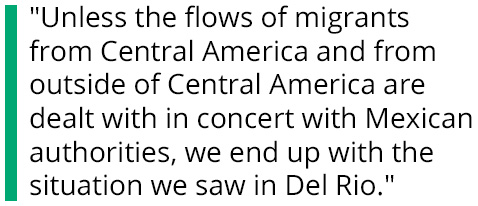 But here’s the catch and here’s the broken dimension of the system. There are now 1.2 million cases backlogged in the immigration system. So when someone comes to the border today, claims asylum, so-called passes the credible fear test, he or she and their family is paroled into the country and given a notice to appear in an immigration court two, three or four years into the future. It appears that far fewer than 50 percent of those people ever show up at the immigration court. They rather are then incorporated into communities and disappear from sight. Of those that do show up, then about 70 percent just discontinue their petitions. About 30 percent of the petitions are granted and the majority of those who show up are not granted asylum by the immigration judge.
But here’s the catch and here’s the broken dimension of the system. There are now 1.2 million cases backlogged in the immigration system. So when someone comes to the border today, claims asylum, so-called passes the credible fear test, he or she and their family is paroled into the country and given a notice to appear in an immigration court two, three or four years into the future. It appears that far fewer than 50 percent of those people ever show up at the immigration court. They rather are then incorporated into communities and disappear from sight. Of those that do show up, then about 70 percent just discontinue their petitions. About 30 percent of the petitions are granted and the majority of those who show up are not granted asylum by the immigration judge.
That’s what accounts for these flows. Now, going back to your specific question about the dangerous journey. You ask, “Well, how do they get to the border to find the Border Patrol agent?” Well, they do that by hiring a smuggler in the sending country, Honduras, Guatemala, El Salvador, in the case of Central America. These smugglers charge. Now the rate is far higher than it used to be. It’s $10,000 to $15,000 or more a person. They’re taken through Mexico and because it’s become such a lucrative illicit activity, transnational organized crime has got involved in Mexico, and there are plaza fees and taxes that are charged all the way along the journey.
And frankly, the migrants are subjected to an enormous set of abuses in terms of physical abuse, sexual abuse, and other dangers to the migrant. So it’s a dangerous journey, but people take it because they can get to the borderline and then most of them are now being admitted into the United States. That this system [encourages] smugglers to bring migrants to the borderline is one of the more, in my view, egregious elements in the current situation, which is what leads to the suggestion that we actually move the process, consistent with our earlier discussion about enlisting time and space to deal with problems away from the borderline, that we avoid the chaos at the border, that we avoid this abuse of the immigration system by actually providing opportunities for migrants and asylees to claim asylum in their home countries in a protected space guaranteed by the United States, but also multilaterally by a group of countries, including Canada, Mexico, Costa Rica, Panama, Columbia, where you would have a protected space and where we could actually see a petition adjudicated not in four years, but rather within six months. And where people needed protection, they would be afforded that protection.
The truth is, and listen, I’m the grandson of immigrants so this is not an anti-immigrant perception or feeling on my part, but the fact of the matter is most people who are coming into the United States in irregular fashion are doing so by the abuse of the asylum system. My recommendation would be that we move this process offshore, and we could talk about how that might work, and that we also vastly expand the lawful means of entering this country and we organize to permit people to do that. The H-2A visa for agricultural workers, there are an unlimited number available to grant. In fact, most Mexicans who are now still working in the fields of America to pick the crops that end up on our table are actually coming in through lawful means of the H-2A visa. A similar program could be set up with regard to other skills and trades where we need the painters, the carpenters, the electricians and the workmen, and women, that [now] come in here and work in [an] exploited, under-the-rug method.
 So let’s do two things, let’s fix the asylum system so that we actually have respect for the rule of law and we create a deterrent to this uncontrolled flow, moderated by smugglers and organized crime. We permit people also to come here in a lawful way and I think that would be a good example, DW, of how you could manage a problem away from the borderline with policies and approaches that stand the chance of working, but you’ve got to be in a position to compete with the underworld of globalization. So the State Department under the Obama administration, for example, had a Central American migrant petition process in Central America in the Northern Triangle countries. But it took three years or more to process and a smuggler was promising to get people to the U.S. border within four to six weeks. So we actually have to make this work if it’s to have credibility with the population that it’s intended to influence.
So let’s do two things, let’s fix the asylum system so that we actually have respect for the rule of law and we create a deterrent to this uncontrolled flow, moderated by smugglers and organized crime. We permit people also to come here in a lawful way and I think that would be a good example, DW, of how you could manage a problem away from the borderline with policies and approaches that stand the chance of working, but you’ve got to be in a position to compete with the underworld of globalization. So the State Department under the Obama administration, for example, had a Central American migrant petition process in Central America in the Northern Triangle countries. But it took three years or more to process and a smuggler was promising to get people to the U.S. border within four to six weeks. So we actually have to make this work if it’s to have credibility with the population that it’s intended to influence.
DW Gibson: Yes. It’s easy to see [the benefits of] a.), creating more avenues for people to come into the country legally to meet labor needs and so forth, and b.), creating a safer asylum process that is more well defined in terms of what asylum is and allows people to apply in their home country or home region. Those two items all by themselves deal with a large majority of people that are showing up at the southern border. It’s easy to see it correlate. The devil is in the detail, in terms of international cooperation and collaborations and what they look like, and everyone being able to maintain sovereignty but still work together.
I know there are so many different drivers for migration too, that we’ve talked about, politics, and you talk about economics and climate as well. Right? And then health. We’ve been dealing with the pandemic for the last couple of years, and we’ve had some recent developments or, I guess, we restarted the Remain in Mexico program, but also, too, there’s been the continuity with Title 42. And so I wonder if you could talk just a little bit about that. And if you see other examples from previous pandemic scares, H1N1, SARS, that could inform us about how we deal with migration as it pertains to pandemics. This is something we’re going to be wrestling with for the foreseeable future.
Alan Bersin: Yeah. So let’s take the infectious disease as the first case. Obviously, that’s something that needs to be dealt with away from the borderline, but what we’ve been doing and we’re now starting to do it again as the new variant shows up, we start to see new restrictions on border travel and we can understand that from a political point of view. What we don’t have is the data that actually supports that that’s the viable approach to dealing with a pandemic. What we did starting with the Trump administration and it continued up until November of this year with the Biden administration is we shut down the U.S.-Mexico and the U.S.-Canada borders to so-called non-essential traffic. Well, this wreaked havoc on local border communities, but it also was a huge burden on family members and we simply can’t be lumping people together into a category and saying, “We’re keeping all of these people out.”
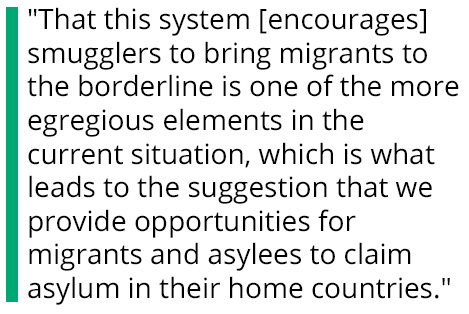 I mean, there are definitely ways to incorporate public health into the Homeland Security and border security protocols and regime at the border. Testing, proof of vaccination, I mean, we need to actually do that rather than taking the zero tolerance attitude. And you raise Title 42. That’s a good example of something that was put in place by the Trump administration and has remained in place by the Biden administration. And the truth of the matter is that it’s a tool that mostly goes to permitting the government to expel or keep people out of the United States. In the case of the Trump administration, that suffered from such an appalling lack of empathy, even to the Biden administration, which in my view, sometimes and often suffers from an excess of sympathy, this is used to repel single males and to just move them [back] across the border without process.
I mean, there are definitely ways to incorporate public health into the Homeland Security and border security protocols and regime at the border. Testing, proof of vaccination, I mean, we need to actually do that rather than taking the zero tolerance attitude. And you raise Title 42. That’s a good example of something that was put in place by the Trump administration and has remained in place by the Biden administration. And the truth of the matter is that it’s a tool that mostly goes to permitting the government to expel or keep people out of the United States. In the case of the Trump administration, that suffered from such an appalling lack of empathy, even to the Biden administration, which in my view, sometimes and often suffers from an excess of sympathy, this is used to repel single males and to just move them [back] across the border without process.
The question though is, if you had testing, you had checks of some kind, that’s the way I would much prefer to see the border regulated rather than with these meat cleavers of zero-tolerance policies that have tended to be the response of the government. That’s not to say we shouldn’t be wary of infection from abroad, but as we’ve seen, most of the infection that our country suffers from is not generated from abroad. It may start [abroad], and we want to be cognizant of that, but we have to have much more measured policies in terms of dealing with public health issues. That was, in some way, the key to the H1N1 situation in 2009. What characterized that response was a very cooperative approach between public health authorities, local, state and national in Mexico and the United States. It was centered in the beginning down in San Diego, Tijuana, Baja California, and California. County health authorities on both sides did a magnificent job of identifying it and controlling it. We need to actually build the institutional means and methods of doing that so it doesn’t have to be reinvented with every new infectious disease because like it or not, in a global world, this has become a feature that we will have to be able to deal with continuously into the future.
Similarly with regard to your point about climate, migration is likely to continue at the unparalleled pace that we’ve seen, not only because of the push factors of poverty, lack of economic opportunity, of violence of all varieties, but also because of climate change, we’re going to be seeing huge impacts on agricultural areas and the way of life of campesinos and peasants all over the world will be in turmoil.
As a result of that, we’re going to be seeing a dramatic migration, irregular migration, of the kind that we’ve seen over the last 10 years. Or actually it’s more 40 years if you go back to the height of the beginning of Mexican migration to the U.S. We’re going to see it, but not only in the United States. You can see it happening in Africa, in central Asia. In Africa as people move toward the European Union. So these are the problems that we react to and I suggest that the answer is not rejecting globalization, but rather taming it and dealing with its consequences in a much more effective and sensitive way.
DW Gibson: Yeah. Well, piggybacking on the topic of climate, there are really clear case studies, too, or the data available to us in terms of regions of the world that are hard hit by climate factors, having been regions of the world that have been pilfered for generations in terms of natural resources and so forth. A country like Honduras, for instance, has endured intense flooding over the last several years, right? With millions of people displaced. Yet they have one of the smallest climatic footprints in the world in terms of a national footprint. Yet that population is dealing most severely with some of the impacts of climate change. So we see there that interconnectedness, that globalization playing out right there in that one example.
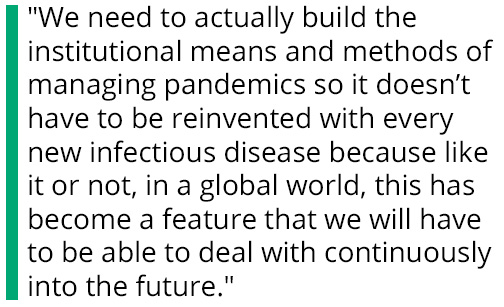
I wonder, with that in mind, one important “frontline” when it comes to border security is stability of our region, right? From an American perspective. That means not only North America, but the Americas. I know it’s a fraught history in terms of U.S. engaging neighbors in good ways and in destructive ways. But how do you see the U.S. effectively being a force for stabilization in the region when it comes to addressing these front lines?
Alan Bersin: Yeah, so the days of gunboat diplomacy properly are over. This is no longer a situation where, whether to collect revenue or to impose a U.S. will, we use kinetic force and military force to achieve it. But what we need to do is to build the multilateral capacity to actually affect change. So you’ll often hear in the immigration debate the argument from the left that says, “Well, we really have to deal with all of those push factors out of Honduras, for example, if we expect to see the results moderated at the U.S. border.” Then you hear the talk about, “Well, we need to put development funds into this.” There’s no question that that is the answer, but it’s a long-term answer. It’s an answer that requires decades, not years, to achieve.
If you look at the migration of Mexico toward the United States, that’s decreased significantly, although it’s increased in the past year, but it decreased such that by 2017, The Pew Foundation had identified and shown that more Mexicans were leaving the United States voluntarily and involuntarily than were entering the United States legally or illegally. Well, that was not so much a function of U.S. border security as it was the growth of Mexico. Nearly 50 percent of Mexico today is middle class by any set of metrics; health, income, education, fertility rates, death rates. I see my friend Vicente Calderón raising his eyebrows, but while differing with me on details, he’ll have to agree with me that Mexico is a far different country today than it was in 1960 at the end of the Bracero program. That’s what accounts for the fact that Mexican [migration], for the most part, although it’s increasing now for reasons we can discuss, but it’s been decreasing steadily over the last decade.
But the point is these development efforts take decades. I referenced the end of the Bracero program. That took place in the mid-1960s and it took a full generation before we began to see the impact in terms of domestic situation in Mexico and its effect on the border in the United States. So when I hear people say, “Well, we really don’t need to deter people from coming from Central America. We need to fix the conditions,” I think we have to recognize that the countries of Central America that send most of the migrants to us are actually, and I say this — I hope it’s tough, but it’s respectfully said — they are quasi states. These are countries that cannot provide a citizen security for their people. They cannot provide economic opportunity for their people and yet they claim the sovereignty of the Westphalian system so that there is an inability to actually affect the highly oligarchic nature of that society, which is not only oligarchic but horribly corrupt, such that you can actually see meaningful change. The incremental programs, again, respectfully to the state department and to my many former colleagues at AID who work very hard on this and I respect them for, but the fact is incremental programs, mental health programs, gang programs, employment programs, they’re band aids on a hemorrhage that requires dramatic action.
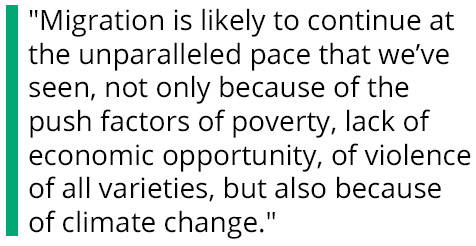 Then to your question, DW, well, how do you get action there? If you’re not going to resort to gunboat diplomacy, which is not only anachronistic, but not possible, you need a multilateral capacity to force change, to expend the resources, to oversee them, that involves a capacity that is sorely lacking in today’s international system. It is nation states that refuse to relinquish their sovereign power to multilateral organizations, whether it’s the United Nations or the International Civil Aviation Organization, or any of the panoply of post–World War II multilateral organizations that have been established. They aren’t given the resource base or the authority to actually affect change. That needs to happen, but I suggest that we try it first on a regional basis. So if you want to affect change in Guatemala or Honduras or El Salvador, it’s going to take a tough approach, but one that’s joined in by many of the other countries of North America, starting with the United States, Canada and Mexico, but including others. I include Columbia and perhaps Chile in that mix, but you cannot get the change by asking people to give up their privilege and you cannot do it by nibbling away at the edges, because that will never produce the change. Even if you had the fundamental social change you need, it would take decades to trickle down, so to speak, and have a real effect on the external migration of people from those countries.
Then to your question, DW, well, how do you get action there? If you’re not going to resort to gunboat diplomacy, which is not only anachronistic, but not possible, you need a multilateral capacity to force change, to expend the resources, to oversee them, that involves a capacity that is sorely lacking in today’s international system. It is nation states that refuse to relinquish their sovereign power to multilateral organizations, whether it’s the United Nations or the International Civil Aviation Organization, or any of the panoply of post–World War II multilateral organizations that have been established. They aren’t given the resource base or the authority to actually affect change. That needs to happen, but I suggest that we try it first on a regional basis. So if you want to affect change in Guatemala or Honduras or El Salvador, it’s going to take a tough approach, but one that’s joined in by many of the other countries of North America, starting with the United States, Canada and Mexico, but including others. I include Columbia and perhaps Chile in that mix, but you cannot get the change by asking people to give up their privilege and you cannot do it by nibbling away at the edges, because that will never produce the change. Even if you had the fundamental social change you need, it would take decades to trickle down, so to speak, and have a real effect on the external migration of people from those countries.
DW Gibson: Yeah. As you point out there, I think aptly so, while there are some quasi states in the region, so to speak there, there are some very stable states as well that could be good partners in that multilateral effort.
We’re just about out of time, but I couldn’t have you call out Mr. Calderón without giving him the chance [to respond] if he’d like. I could ask my colleague Ariel to unmute him. If you have a question for Mr. Bersin or even a response to that, Mr. Calderón, I invite you [to share it], although I don’t want to put you on the spot.
Vicente Calderón: Thank you. First, I have a lot of respect for Mr. Bersin. We collaborated from different fronts in the late ’90s, me from the press perspective and he from the [inaudible]. But I think the problem for me is that we have seen changes in a very different direction. I think we have more people poor now. We have a lot of more millionaires in Mexico, more wealthy people. The gap is widening a lot in similar ways to what is going on in the U.S. We were in many cases not in agreement, but I have a lot of respect and I think I have to commend him for putting his money where his mouth was and investing in the border to be able to make this a point of development with a better perspective from the rest of the country, because we have been seeing here the changes.
 He was perfectly right. We have a decrease in the number of migration from Mexicans, but that was also because of the economic crisis in the U.S. So people were not being pulled for the incentive of going to the U.S. I think I’m very sorry that I was not able to be here from the beginning, but I was very, very much interested because what we need are more of the [inaudible] like Mr. Bersin, because what they’re going through with the government in Mexico, with all these [inaudible] programs, the situation is changing a lot. Now we are seeing an increase again on Mexicans going towards the U.S. But the problem is that we became more like an international route. We have a big [number of] people from Brazil going through here, from Russia, from Venezuela. So I just want to remind you guys to put attention on this particular perspective and thank Mr. Bersin for the input in general.
He was perfectly right. We have a decrease in the number of migration from Mexicans, but that was also because of the economic crisis in the U.S. So people were not being pulled for the incentive of going to the U.S. I think I’m very sorry that I was not able to be here from the beginning, but I was very, very much interested because what we need are more of the [inaudible] like Mr. Bersin, because what they’re going through with the government in Mexico, with all these [inaudible] programs, the situation is changing a lot. Now we are seeing an increase again on Mexicans going towards the U.S. But the problem is that we became more like an international route. We have a big [number of] people from Brazil going through here, from Russia, from Venezuela. So I just want to remind you guys to put attention on this particular perspective and thank Mr. Bersin for the input in general.
Alan Bersin: Yeah. So DW, just to pick up on something that Mr. Calderón said, if you check the data, this is almost 40 percent, just under 40 percent of the people that are now coming to the U.S. border are actually not from either Central America or Mexico. As he points out, these are people coming from all over the world, from the western hemisphere, from the eastern hemisphere and they are people that are coming and this is a problem that unless there is a deterrent put in effect, what we’ve seen from Central America will now become a worldwide phenomenon in terms of people coming to South America. Many people fly into countries that don’t require visas, such as Brazil, and then people come up with smugglers and they’re coming through the Darien Gap.
Now, the Darien Gap between Colombia and Panama is one of the great natural settings that remains in the continent, but it’s becoming a highway littered and destroyed by the movement and the traffic of the people by foot. I mean, that’s the one place in the Pan-American highway that goes from Canada to Chile that was not paved, but rather preserved because of both its wildness [and] its beauty. That’s now a highway for migrants coming up through Central America, into Colombia, through Panama, and then showing up at the U.S. border, almost 50,000 people a month now.
DW Gibson: Yeah. I think that another thing that stood out to me that Mr. Calderón said there was the shared experience in both the U.S. and Mexico in terms of economic inequality and how we’re wrestling with those issues. I highlight that because it shows that many nation states are wrestling with the same issues and that can be common ground that we build off of to go from there.
So I think we’re just about out of time, although we did have a request for one more question and Ariel, [please] unmute Alisa Reznick, who I think has a question for us.
Alisa Reznick: I just had one quick question as a follow-up to some of the conversation about Title 42 and other border policies right now. So the CDC just extended 42 along the border again and here in Arizona, even migrant families who are able to produce proof of vaccination and negative COVID tests are still barred from taking steps towards claiming asylum at ports of entry. Aid groups and legal groups warn that this dynamic has kind of pushed more people to make those dangerous desert crossings that we were just talking about. So I guess for Mr. Bersin, in terms of your expertise in policy and history of policy, why is a policy like this still in place despite numerous public health experts describing why it doesn’t work on a public health basis? Then are there past policies that are similar?
Then the last question for you related to this, as the number of people migrating for various reasons is increasing, why not build that ability to process the claims right there at the border?
Alan Bersin: Yeah. Well, because if you give incentives for smugglers to bring people to the border, they won’t stop coming, particularly if they’re paroled into the United States to wait for an immigration court hearing that takes two or three or four years. I mean, if we had immigration asylum processes that were carried on, much as refugee policies or programs are carried on away from the borderline, you could let in people who were deserving of protection and you could do it in great numbers, but you wouldn’t have the incentive for people to come to the border, claim asylum when in fact most of them are not entitled to it. So the question is if people from Nepal are seeking asylum, we should have a mechanism for them to seek it, not at the U.S. border, but rather in a place away from it. The refugee and asylum standards are actually the same and if we conflated asylum processes and refugee processes, we could retain the ability to give people who need protection protection, but also deter those who are actually abusing the system.
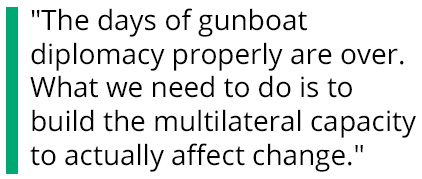 On Title 42, Ms. Reznick, I think frankly the reason that it was put into place by the Trump administration was to use it as a tool to exclude everyone from crossing the border, and that’s the way it was applied. With respect to the Biden administration, they have used it for the most part to remove single males. My understanding is that most families and all unaccompanied children are actually being permitted into the country without regard to Title 42.
On Title 42, Ms. Reznick, I think frankly the reason that it was put into place by the Trump administration was to use it as a tool to exclude everyone from crossing the border, and that’s the way it was applied. With respect to the Biden administration, they have used it for the most part to remove single males. My understanding is that most families and all unaccompanied children are actually being permitted into the country without regard to Title 42.
So the issue on Title 42 is not so much with regard to irregular migration, but are you going to use it to go back to where we were before November, where we were using it to block lawful traffic of people across the U.S., Mexico and Canada borders.
At the minimum, we should have the same process that we have now for airlines. You have to establish that you were tested and to my mind, depending on CDC guidance and public health guidance, vaccination status obviously should be a key. So Title 42 serves a political purpose for the Biden administration as it did for the Trump administration. They use it slightly differently, but in both cases, I would use it in a much more discriminating, careful and defined manner than making it a blanket to keep lawful travel out of the U.S.
DW Gibson: Well, I think we’ve run over our time here, but in a very productive way. I appreciate your very, very thorough answers, Mr. Bersin, and your perspective. I think that we could carry on for several more hours, but hopefully we’ll have you back for some other targeted conversations in the future. I thank everyone for joining us today and I thank you for your expertise. Thank you, Mr. Bersin.
Alan Bersin: Thank you.
DW Gibson: All right, everyone. Be well, and we’ll see you next time.
Read More:
